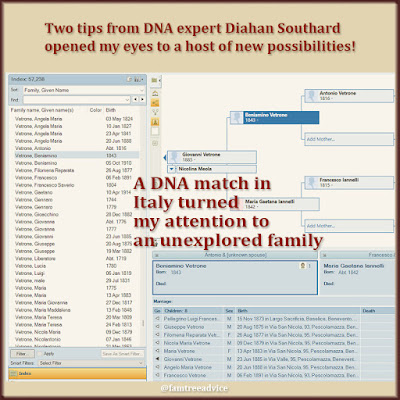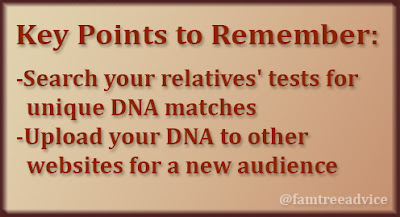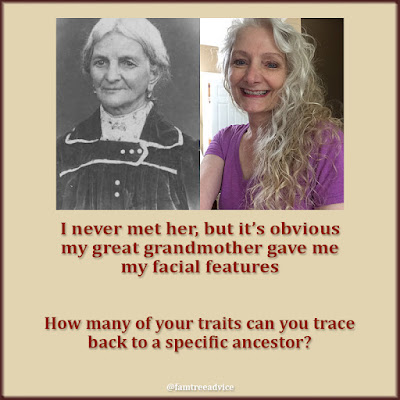Ten years ago I asked my parents to take a DNA test. I told them it would help me see whether my matches were on mom's side or dad's side. I even uploaded our 3 DNA tests (plus my husband's) to other DNA websites.
I must admit I've spent very little time looking at their DNA matches. Instead, I've analyzed the daylights out of my matches. I've categorized them, added notes, and grouped them with colorful dots.
Then on Friday, DNA expert Diahan Southard gave another insightful webinar. She recommended two things I've overlooked:
- My parents are one generation closer to their ancestors than I am. So they will have some matches I don't have.
- AncestryDNA has the most tests by far, but they ship to a limited number of countries. (See the full list.) Other websites, like MyHeritage, have a more global collection of DNA testers.
After hearing that second point, I was eager to see our matches on MyHeritage. Sure enough, I'm seeing matches that aren't on AncestryDNA. They're from:
- Italy
- Brazil
- Australia
- United Kingdom
- Venezuela
- Slovakia
- New Zealand
- plus the USA and Canada
 |
| I didn't realize how AncestryDNA limits my international pool of matches. |
You can do this for free, same as I did. Create a free account on www.myheritage.com, go to the DNA menu, and choose Upload DNA data. (See your testing site for instructions on how to download your DNA data file.)
I'll bet you'll have much better matches than I do. For some reason, my number of matches is very low compared to other people. On AncestryDNA, I have 5,554 matches. I've seen other people with 50,000 matches. What the heck? On MyHeritage, I have 554 matches—but 90% of them are people not on AncestryDNA.
I spent a whole day looking at the family trees of DNA matches for my parents and myself on MyHeritage. The most exciting result is that many of them are from my mother's ancestral hometowns in Italy. Those towns have almost no matches on AncestryDNA!
 |
| Don't overlook the free resource that offers you a host of new international DNA matches. |
I recognize most of the last names in these matches' family trees. I dug through my downloaded collection of vital records from the towns. I built out families and placed my new DNA matches in my family tree. Sometimes our connection was an in-law connection, not a cousin connection. That means I need to piece together more ancestors.
While my number of international DNA matches is low, they give me a lot more families to explore. I'm excited to have a new project on my list. Yes, I'm still winding up a cleanup project to add source citations to some document images in my family tree. But I can wrap that up in three solid days. And I'm still working through my maternal grandfather's hometown, adding people to my tree. And I'm even still renaming lots of my downloaded vital records to make them searchable.
But that doesn't mean I'm not excited by the next big project! Thanks to my international DNA matches, I can expand my reach into my "underserved" towns:
- Sant'Angelo a Cupolo
- Apice
- Pescolamazza
- Santa Paolina
- Tufo
I'm also revisiting the DNA kit I uploaded to familytreedna.com. That match list (only 321 people) has even more names I haven't seen on AncestryDNA. Very few of them have uploaded a tree, so I may not get very much out of this list. But again, I'll bet you will.
I'm eager to add as many people from my underserved towns as possible. My family tree is full to the brim with ancestors from my grandfathers' hometowns. But my grandmothers' lines need work. Now I can expand their families further!
If your family hasn't been in the U.S., U.K., Canada, Ireland, Australia, or New Zealand for several hundred years, don't ignore the power of MyHeritage. And if you're managing DNA kits for your close relatives, explore their unique matches. Go ahead. Dip your toes in the international gene pool.




